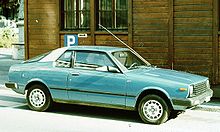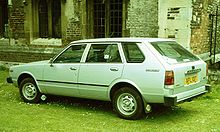- Nissan Cherry
-
Datsun Cherry/Nissan Cherry 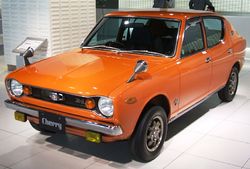
Manufacturer Nissan Production 1970–1986 Successor Nissan March Class compact car The Datsun Cherry (チェリー), known later as the Nissan Cherry, was a series of small cars which formed Nissan's first front-wheel-drive model line.
The Cherry featured FF layout, meaning front-engine, front-wheel drive. The Cherry line includes the E10 and F10. Nissan's direct successor FF model line was the Nissan Pulsar, still named in some markets as "Cherry".
In Italy, Alfa Romeo built a derivative of the N12 series known as the Alfa Romeo Arna, which Nissan also sold in the European market as the Nissan Cherry Europe and in Japan as the Nissan Pulsar Milano. These cars had only minor appearance differences: radiator grilles, steering wheels, fabrics, etc. were different.[1]
Contents
Background
Originally, before combining with Nissan Motors, the Prince Motor Company plan of development was to mass produce a front-engine front-wheel-drive car, but after the Prince and Nissan merger of 1966, the Cherry was released in 1970 as Nissan's first front-wheel-drive car. In Asian markets there was also a "Cherry Cab" cabover truck model, which was closely related to the Cherry car and the Prince Homer.
History
1st Generation E10 Series (1970–74)
Nissan Cherry E10 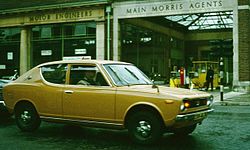
Datsun 100A Cherry 2 door 1972 (European contemporary nomenclature)
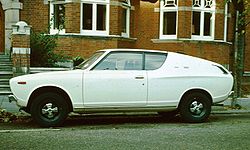
Also called Datsun 1000
Datsun 100A
Datsun 120AProduction 1970-1974 Body style 2-door sedan
4-door sedan
3-door hatchback
2-door coupéPlatform FF layout Engine 988cc A10 Straight-4
1.2L A12 Straight-4Transmission 4-speed manual
all-synchromeshWheelbase 92 in (2,337 mm) Length 142 in (3,607 mm) Width 58 in (1,473 mm) Height 54.375 in (1,381 mm) The E10 generation featured four-wheel independent suspension.
The E10 was fitted with two types of inline four-cylinder Nissan A-series OHV engines:
- 988 cc A10
- 1171 cc A12
The JDM Cherry X-1 model featured twin-carburetted A12T engine with dual-sidedraft Hitachi carburettors.
In Europe, E10 was called Datsun 100A (the Datsun brand being used in place of Nissan in the European market at that time) (with A10 engine) or Datsun 120A (A12, but this engine was only available with the coupé body style). Reportedly, market names of Cherry and Datsun 1000 were also used, however the Datsun 1000 name was associated with the early Nissan Sunny and Nissan Bluebird. The Cherry was introduced in Japan at a specially established dealership sales channel called Nissan Cherry Shop
In the early 1970s, as the British auto-industry faltered, Datsun led the charge of Japanese auto-manufacturers rapidly gaining market share in the UK. Britain's Motor magazine polled readers about their cars, including, in February 1973, those who owned E10 Cherrys. The question given greatest prominence was the final one which asked whether or not respondents would buy another car of the same model: 76% of Cherry owning respondents answered “yes”, which was the top score for this question achieved by any model to date, and beat even the 66% “yes” score given by owners of the previous leader, the Volkswagen Beetle, at the time well known in the UK for its owners’ ferocious brand loyalty.[2]
Timeline
- 1970 October: E10 goes on sale in Japan. At the beginning were setting only of four-door sedans and two-door sedans.
- With 1970: 17th Tokyo motor show, exhibiting the concept car "270X" which designates the Cherry as the base.
- 1971 end of September: coupé version added
- 1972 March: three-door van version added
- Cherry coupé debuts in 1972 April race Japan. As a Nissan works entry, it participated also in other domestic Japan races.
- 1972 June: minor model change
- 1973 March: debut of Cherry Coupé 1200X-1 R with "fender flares"
- 1973: Revised model with updated grill, rear lights and hubcaps released
- 1976: Acropolis Rally privateer entry
- 1977: E10 production ceases
2nd Generation F10 Series (1974–78)
Nissan Cherry F-II (F10)  Datsun 100A F-II 1977 (A10 engine) 2-door sedan
Datsun 100A F-II 1977 (A10 engine) 2-door sedanAlso called Datsun F-II
Datsun F10
Datsun 100A F-II
Datsun 120A F-IIProduction 1974–1978 Body style 2-door sedan
4-door sedan
3-door station wagon
2-door coupéPlatform FF layout Engine 988cc A10 Straight-4
1.2L A12 Straight-4
1.4L A14 Straight-4The second-generation Cherry was known as F-II in Japan and "Datsun F10" in North America. It was Nissan's first front-wheel-drive model to be sold in North America. Four-wheel independent suspension continued to be used.
The F10 was fitted with three types of inline four-cylinder Nissan A-series OHV engines:
- 988 cc A10
- 1171 cc A12
- 1397 cc A14
A two-pedal type semi-automatic transmission was offered called the "Sportmatic", which used a torque converter obviating the need for a clutch.
In Europe, F10 was known as Datsun 100A F-II (with A10 engine) or 120A F-II (with A12 engine). The A12 powered 120A F-II was the most common model.
In New Zealand the 100A 4-door sedan (1.0L A10 motor) was assembled CKD as a price leader for the Datsun range - due to the choice of engine, it was the smallest engined car assembled in New Zealand, the engine (988cc) being smaller than the Mini's 998cc unit. Production continued well after the N10 model replaced it overseas, eventually being discontinued in late 1980, the N10 5-door hatchback replacing it in 1981.
In North America, only the coupe and wagon were offered.
Timeline
- 1974 September: Sale started in Japan. Body styles included 2 and 4 door sedans, a coupe, and a 3-door wagon.
- 1978: Swedish Rally privateer entry
- 1978 May: The Datsun Pulsar (N10 type) appeared as a successor model to the Cherry. At the time the Cherry name was discontinued on the Japan home market.
Nissan Pulsar (N10) generation
Nissan Pulsar N10  Datsun Cherry, known as the Nissan Pulsar N10 in some markets
Datsun Cherry, known as the Nissan Pulsar N10 in some marketsAlso called Nissan Pulsar
Datsun Pulsar
Nissan Langley (Japan)
Datsun 100A
Datsun 120A
Datsun 130A
Datsun 140A
Datsun 150A
Datsun 310Production 1978–1982 Body style 2-door fastback sedan
4-door fastback sedan
3-door hatchback
5-door hatchback
3-door coupé
3-door panel van
5-door station wagonPlatform FF layout Engine 988cc A10 Straight-4
1.2L A12 Straight-4
1.4L A14 Straight-4
988cc E10 Staright-4
1.3L E13 Straight-4
1.5L E15 Straight-4Related Nissan Sunny
Nissan VanetteThe N10 model of 1978 was known as the Nissan Pulsar in Japan, but was called Cherry in Europe. The body styling was more boxy, and influenced by designs coming out of Europe at that time, although in practice, particularly in wagon form, elements of the styling looked remarkably similar to the Toyota Corolla and Honda Civic of the time. Engine choices were carried over from the previous model, consisting of Nissan's A-Series motor in 1.0L, 1.2L and 1.4L forms.
A unusual styling feature for the car was its long nose - which was due to Nissan envisaging that the car would also be built a with longitudinal rear-wheel-drive layout for developing markets - however only front-wheel-drive models were actually built.
Circa 1980 Datsun Cherry Coupé (European nomenclature) which is the same as a Nissan Pulsar (N10) model
The N10 Cherry was available in a wide variety of bodystyles, which consisted of 3 and 5 door hatchbacks, 2 and 4 door fastback sedans (which utilized the same body profile as the hatchback models), a hatchback coupe, a 3-door van and 5-door wagon variants. Most markets outside Japan did not receive all versions: for instance, 3- and 5-door hatchbacks and the coupe were the only models offered in the US.
Later in the car's production life, 1981, the entire range was repowered by Nissan's newly developed OHC E-series motors. The car also had a facelift, involving a new grille and rectangular headlamps.
In 1982 Nissan badges began to appear on the cars, due to Nissan phasing out the Datsun name at that time for its international markets. Production ceased in mid-1982, to be replaced by the all-new N12 Cherry series.
Cherry (Pulsar N12 generation) and Cherry Europe
Nissan Pulsar N12 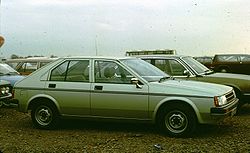 Nissan Cherry N12 side view
Nissan Cherry N12 side viewProduction 1982–1986 Body style 3-door hatchback
4-door sedan
5-door hatchbackPlatform FF layout Engine 1.2 L Flat-4
1.3 L Flat-4
1.5 L Flat-4Related Nissan Cherry Europe
Nissan Pulsar Milano
Alfa Romeo ArnaThe Cherry name was still used in Europe on the model N12, an angular, hatchback design.
Derivative of Cherry N12 was also built by Alfa Romeo at Pratola Serra, near Naples, Italy. The Alfa-built version was badged as either the Nissan Cherry Europe or the Alfa Arna in Europe (depending on the dealer supplying it), and as the Nissan Pulsar Milano in Japan, and is distinguishable by slightly different rear light clusters and other minor changes. Under the skin it used Alfa Romeo Alfasud-based components including the engine, transmission, and front suspension. Rear suspension and body panels came from Japan. Both Italian- and Japanese-built versions were available in European markets, but the Italian version helped to overcome strict import quotas imposed on Japanese cars at the time. Arna was an acronym meaning Alfa Romeo Nissan Autoveicoli. The Arna did not sell well and the partnership was not continued.
A high performance turbo version of the Cherry was available for part of the N12 model's life.
After the end of Cherry production, the Sunny was Nissan's only offering of this size in Europe. In America only the notchback coupe ("Pulsar NX") was offered for most of the N12's run although the 3- and 5-doors were sold in 1983 only.
Replacement by Nissan Sunny
In most export markets, the Nissan Sunny name replaced the Cherry starting with the N13 Pulsar model. In certain markets such as Greece, however, the N13 Pulsar retained the "Cherry" nameplate.[3]
In Japan and some Asian markets, the Pulsar name was used until N15 model. See the Pulsar entry for more information.
See also
- Nissan Motors
- Prince Motor Company
- Nissan Pulsar
- RatDat.com - paint colors, sales brochures, and model names
- Japan Wikipedia article "Nissan Cherry"
References
- ^ "ARNA". alfasud.alfisti.net. http://alfasud.alfisti.net/ase13.html. Retrieved 2007-10-29.
- ^ "On the road". Motor: page 30. 3 February 1973.
- ^ Mastrostefano, Raffaele, ed (1990) (in Italian). Quattroruote: Tutte le Auto del Mondo 1990. Milano: Editoriale Domus S.p.A. p. 599.
Nissan Motor Company Vehicles Current370Z • Advan • Altima • Aprio • Armada • Atlas • Bluebird • Bluebird Sylphy • Cabstar • Caravan • Civilian • Clipper • Cube • Dualis • Elgrand • Frontier • Freeson • Fuga • GT-R • Juke • Lafesta • Leaf • Livina Geniss • Maxima • March • Murano • Moco • Navara • Note • NV200 • NV400 • Otti • Paladin • Pathfinder • Patrol • Qashqai • Quest • Rogue • Safari • Sentra • Serena • Skyline • Teana • Tiida • Titan • Urvan • Versa • Wingroad • X-Trail • XterraPastDC-3 • 100NX • 1200 • 310 • 180SX • 200SX • B-210 • 240SX • 240Z • 280ZX • 300C • 300ZX • 350Z • 510 • 810 • Almera • Almera Tino • Altra (EV) • Avenir • Auster • Bassara • Be-1 • Caball • Cablight • Cedric • Cefiro • Cherry • Cima • Crew • Datsun Truck • Echo • Expert • Fairlady • Figaro • Gazelle • Gloria • Hardbody Truck • Hypermini • Homy • Interstar • Junior • Largo • Laurel • Leopard • Liberty • Mistral • Multi • NX • Pao • Pintara • Pino • Platina • Prairie • Presage • Presea • Primera • President • Pulsar • Pulsar GTI-R • R390 GT1 • R'nessa • Rasheen • Roadster-Road Star • S-Cargo • Saurus • Saurus Jr • Silvia • Sileighty • Skyline GT-R • Stanza • Stagea • Sunny • Terrano • Terrano II • Vanette • VioletConcept126X • 216X • 270X • 300 Bambu • 315-a • AA-X • Actic • AD-1 • AD-2 • AL-X • Alpha T • Amenio • AQ-X • AP-X • ARC-X • AXY • AZEAL • Bevel • Boga • C-Note • Chapeau • Chappo • Cocoon • CQ-X • Crossbow • CUE-X • Cypact • Duad • Dunehawk • Effis • ESV • Evalia • EV Guide II • EV Truck • FEV • FEV-II • Foria • Forum • Fusion • Gobi • GR-1 • GR-2 • GT-R • ideo • Intima • Jikoo • Judo • Jura • Kino • KYXX • Land Glider • LEAF • LUC-2 • MID4 • Mixim • mm.e • Moco • Nails • NCS • NEO-X • NRV-II • NX-21 • NV2500 • Pivo • Pivo 2 • Qazana • Redigo • Round Box • Serenity • Sport Concept • Stylish VI • Terranaut • Tone • Townpod • Trailrunner • TRI-X • URGE • UV-X • XIX • XVL • Yanya • ZarootEngines GRX-3 • UD12 • VRT35Marques Nissan • InfinitiSubsidiaries
and divisionsSee also ATTESA • Datsun • HICAS • Prince • Renault-Nissan Alliance • Nissan Shatai • UD Nissan Diesel • VVL • VVEL • dCi
 Category ·
Category ·  CommonsCategories:
CommonsCategories:- Nissan vehicles
- Vehicles introduced in 1970
Wikimedia Foundation. 2010.

